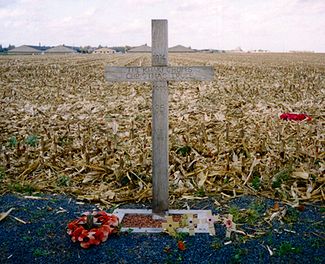Stranger Than Fiction: The Christmas Truce

A cross, left in Saint-Yves (Saint-Yvon – Ploegsteert; Comines-Warneton in Belgium) in 1999, to commemorate the site of the Christmas Truce.
The text reads:
“1914 – The Khaki Chum’s Christmas Truce – 1999 – 85 Years – Lest We Forget
December 24, 1914 started out like many other days during the Great War, now known as World War I. The day began with a barrage of artillery and gunfire between German and British troops entrenched along the western front near Ypres in Belgium. As the hours of Christmas approached a most miraculous event occurred on the battlefield. Late in the day there was a lull on the battlefield as troops rested in their trenches. Soon, British soldiers heard the sounds of Christmas carols coming from the German trenches across the blood-spattered battlefield known as “No man’s land.”
Not to be outdone, the British soldiers began singing a Christmas carol. Moments after the last note was sung, a German officer stepped from his trench and called out to the British. Reluctantly, a few British soldiers stepped from their trenches to meet their adversaries. Within moments, the British and Germans were shaking hands and fraternizing with one another.
Bruce Bairnsfather, a British soldier later wrote: “I wouldn’t have missed that unique and weird Christmas Day for anything. … I spotted a German officer, some sort of lieutenant I should think, and being a bit of a collector, I intimated to him that I had taken a fancy to some of his buttons. … I brought out my wire clippers and, with a few deft snips, removed a couple of his buttons and put them in my pocket. I then gave him two of mine in exchange. … The last I saw was one of my machine gunners, who was a bit of an amateur hairdresser in civil life, cutting the unnaturally long hair of a docile Boche, who was patiently kneeling on the ground whilst the automatic clippers crept up the back of his neck.”
Thus, the festive spirit prevailed and soldiers of both sides began singing carols together in this most unlikely of settings. Soon, someone brought out a soccer ball and the soldiers of the two opposing armies engaged in a friendly game in the middle of the battlefield where only hours earlier they tried to kill one another.
On this field of inhumanity there was peace as the soldiers of both sides exchanged small gifts and told their new friends of their families back at home.
The festive spirit of the holiday spread along the lines and within hours numerous other soldiers had laid down their weapons to embrace the Christmas spirit.
The recently killed soldiers that lay on the battlefield were taken from the battlefield and given proper burials that were jointly attended by men of both sides.
General Sir Horace Smith-Dorrien, commander of the British II Corps, was irate when he heard what was happening, and issued strict orders forbidding friendly communication with the opposing German troops. These orders went largely ignored as the celebration continued. In some regions the unofficial truce continued into New Year’s Eve.
Officers threatened men with court-martial for failing to obey orders and, in some cases, threatened to have men shot for treason.
As the days wore on, and the threats from superior officers became more ominous, the men gradually returned to their trenches and the fighting and killing resumed. But, for a few brief days, almost forgotten by the passing of time and lost in the pages of history, two of the greatest armies on Earth laid down their weapons in homage to the spirit of Christmas.
In 1999, a plaque was placed at the edge of the battlefield where the Christmas Truce took place. The plaque is a silent reminder of that symbolic moment of peace and humanity, when the guns fell silent on the night the angels sang, amidst one of the most violent events of modern history.
Michael Williams is the author of a book entitled “Stranger than Fiction: The Lincoln Curse.” The book is a collection of 50 strange and unusual but true stories. The stories will leave the reader convinced that perhaps Mark Twain was right when he said “truth is stranger than fiction.”
He has written for more than 30 newspapers and magazines including the Civil War Times Illustrated, The Civil War Courier, the Associated Press and the Knoxville Journal.
The book is 187 pages in a softbound edition with numerous photos. The book can be purchased from amazon.com for $19.95 plus shipping and handling or you can save shipping cost and save $2 on the purchase price by ordering a signed copy directly from the author. Send $17.95 to P.O. Box 6421 Sevierville, TN. 37864.
The book is available in Kindle on Amazon.com for $3.99. For more information visit the website www.strangerthanfictionnews.com.












